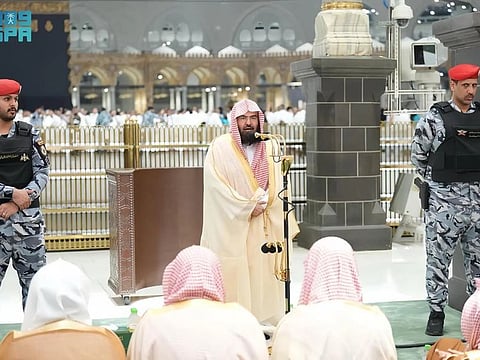Don’t get busy with filming and taking photos at Islam’s holiest sites, Saudi cleric advises worshippers
Mecca, Medina brace for larger numbers of the faithful in Ramadan days ahead

Cairo: As Saudi Arabia’s sacred cities of Mecca and Medina brace to receive more visitors to Islam’s two holiest sites in Ramadan, a leading cleric has a piece of advice to worshippers: Don’t get busy with filming and taking photos there.
“Venerate the time and the holy place,” said chief of Religious Affairs for the Two Holy Mosques Abdulrahman Al-Sudais.
In Ramadan, Muslims from inside and outside Saudi Arabia would head in large numbers to the Grand Mosque in Mecca and the Prophet’s Mosque – both are Islam’s most sacred places. Ramadan usually marks the peak season of Umrah or lesser pilgrimage at the Grand Mosque.
Some worshippers seem interested in cherishing the memory of their presence at the two mosques by capturing footage and photos via their mobile phones.
Al Sudais highlighted a Ramadan-related plan featuring intensified sermons and field awareness courses at both mosques amid expectations of an influx of worshippers.
“The religious set-up at the Two Holy Mosques is prepared to receive pilgrims and other worshippers, and provide them with the highest quality services,” he said in media remarks.
Around 7.5 million Umrah pilgrims accessed the Grand mosque since Ramadan started on March 11, Al Arabiya TV reported, estimating that 10 million other worshippers went to the Prophet’s Mosque in the same period.
Last week, Saudi Arabia banned repetition of performing Umrah during Ramadan to ease overcrowding.
The Ministry of Hajj and Umrah said no permit is issued for performing two or more Umrahs in Ramadan, urging the faithful to make do with one lesser pilgrimage with the aim of easing congestion, giving others the chance to undertake Umrah and helping in crowd management.
To cope with the influx, Saudi authorities have recently unveiled a series of measures to help worshippers perform rites smoothly and comfortably including allocating the circumambulation courtyard around the Holy Kaaba and the ground floor for Umrah pilgrims during Ramadan.
Furthermore, authorities have allocated certain gates of the sprawling mosque for pilgrims’ entry and exit to stave off overcrowding.
Sign up for the Daily Briefing
Get the latest news and updates straight to your inbox



